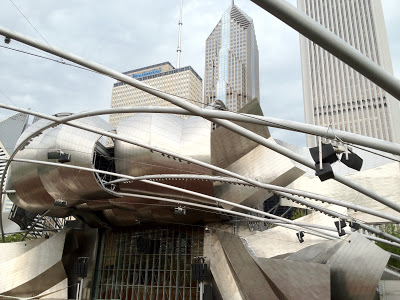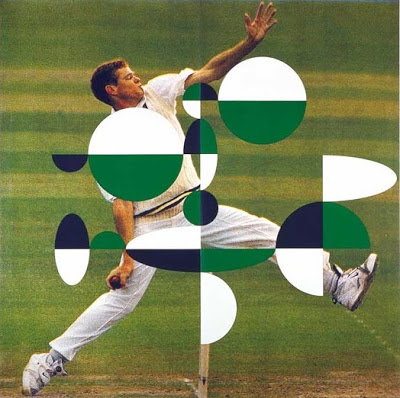Curator Art
Art Vent Letting the Fresh Air In
May 29, 2012
I’m in Barcelona where, for me, the highlight is the best hot chocolate in the world. Known as un suisin Catalan, this is smooth, barely liquid chocolate topped with an equal mound of whipped cream. These perfect opposites—hot and cold, black and white, dense and airy, bitter and sweet—come together in a delectable marriage on your tongue. “Like yin and yang,” says my friend, who won’t allow me to name the café because she doesn’t want it to become more overrun than it already is. Thus far, I’ve been there every day.
And so my love/hate relationship with contemporary art continues. After the previous post about my visit to Chicago, a Facebook friend wrote: “Strong feelings of ambivalence are an indication of deep involvement. Sounds like perhaps you need to choose more judiciously what to see?”
Yes, and no. I want to keep an open mind, and there’s nothing I like better than to have my prejudices overturned, as they were when I realized I liked (some of) Damien Hirst’s spots. I can’t help having opinions, so must constantly guard against turning into one of those loathsome people who spout about things they haven’t seen. However we should keep the question open until after my visit to the Hirst retrospective at the TateModern next week. One thing I know is that, after going to Barcelona’s SWAB fair on Saturday, in the interest of sanity, I should avoid art fairs altogether. At least I got to have a chocolate afterward.
Rather than “young,” the art at SWAB should have been billed as “immature”— adolescent scribbling like you wouldn’t believe. Or maybe you would. Luckily, however, as in Chicago, my inevitable tailspin was mitigated by later seeing spare, graceful, very grown up art, this time Rita McBride at the Barcelona Museum of Contemporary Art(MACBA). While the MACBA building is another example, like the Art Institute of Chicago’s Modern Wing, of harsh white walls and architectural hubris run amok (here that of Richard Meier), every exhibition I’ve seen at MACBA has been beautifully chosen and intelligently executed. Wait, I should say every recent exhibition I’ve seen, thereby excluding a gigantic show in 2005 devoted to Francis Alÿs, whose “diverse body of artwork that explores urbanity, spatial justice, and land-based poetics” (barf!) is a perfect example of what Jerry Saltz has accurately labeled and defined as “curator art.”
Richard Meier, Barcelona Museum of Contemporary Art: Where's the art?
At least MACBA doesn’t have a café. Chicago’s Art Institute, given its monolithic isolation on Michigan Avenue, needs to offer sustenance to the hoards of attendees, but its food optionsclearly reflect its values. For the 1%, there’s the posh, reservations-only Terzo Piano upstairs, while downstairs the other 99% of us are relegated to the euphemistic “Museum Café,” really a cafeteria. Here the gastronomic choices (burger station, pizza station, and sandwiches entombed in plastic) are of food court quality and accompanied by endless petroleum products—despite being a location where no one would, or could, take meals away. I was appalled when I was there, but now visiting in Europe, I’m even more disgusted by our throwaway society. Clearly it was foolish of me to assume that a cultural institution would somehow be conscious of plastic being not only wasteful but unaesthetic (my chocolate, if served in a plastic cup, would not be nearly so tantalizing). I suddenly had the horrifying thought that for current generations of Americans, the concept of reusing crockery at all is likely to seem as antiquated as linen hankies.
Addressing my previous post, Ben F. comments, “The large white box and grand entrance are created to give a sense of permanence in the way banks used to be built. A sense that the bank would be here long after you are gone so that you could trust that your donations (of art/money) would be safe. The large space then needs to be fitted with art to scale.”
Again, silly me! I forgot that the main purpose of any institution is self-preservation, which means that the Art Institute’s primary concern is to secure the wherewithal that keeps it going. And there I was, thinking that it was about art!
Comments (2)
May 27, 2012
I went to Chicago recently, and had a mini art crisis. One dark and stormy Sunday afternoon, blissed out after a morning of kundalini at Yoga in the Loop in the landmark Fine Arts Building, I crossed Michigan Avenue to the Art Institute to see Renzo Piano’s much-touted Modern Wing—and got all cranky.
Anyway, featured in this particular white box on the second floor (Contemporary Art from 1960 to the Present) the walls were lined with deadpan portraits by Dutch photographer Gehry Bandshell, Millennium Park, Chicago
Gehry Bandshell, Millennium Park, Chicago
First of all, while my press cards got me in free, unlike other museums where press are treated like members, I was sent to the regular ticket line, which shrank my allotted hour by more than half. Having only 20 minutes and being pretty familiar with Roy Lichtenstein and photographer Dawoud Bey, the subjects of special exhibitions, I took in the lobby/atrium, and headed upstairs to the galleries displaying the permanent collection—which is where I had my meltdown. OMG I’m SO bored with museums where there is some spectacular entrance, hallway, atrium (or stairway, in the case of Richard Meiers’s Barcelona Museum of Contemporary Art) that serves as a showcase for the architect’s creative genius, his use of natural light and ability to spend millions of dollars, while the art is shunted off to be imprisoned in the same-old-same-old square white boxes with track lighting. Really, if I never see another piece of white-painted drywall again (such a lifeless material!) it will be too soon. I don’t know what the alternative is, but there’s gotta be another way. Perhaps if, instead of designing temples to their egos, architects were to think creatively about new ways art could be displayed, they might come up with something.
Renzo Piano, Modern Wing, Chicago Art Institute: Where is the art?
Anyway, featured in this particular white box on the second floor (Contemporary Art from 1960 to the Present) the walls were lined with deadpan portraits by Dutch photographer
Of course our Marxian friends will surely point out that last week, not far away from “The Bean,” as Chicagoans call the Kapoor, military-style police were bashing the heads of NATO protestors, and that both that action and the sculpture are expressions of the same mayoral power structure.** But does that mean they must be uniformly evil? The truth is that inspiring art makes people want to lead inspiring lives. Boredom achieves nothing.
Anish Kapoor, Cloud Gate, 2004-8.
Anish Kapoor, Cloud Gate, 2004-8, view from underneath.
Anish Kapoor, Cloud Gate, 2004-8.
Anish Kapoor, Cloud Gate, 2004-8, view from underneath.
December 15, 2009

What I wrote below sounded so negative, I wanted to amend it. I don’t want to discount Orozco because, while I find his much of his “conceptual” work tedious, I’m completely inspired by his drawings, small paintings, and collages. It’s just that these are regarded as ephemera rather than the real deal, when I think they are the real deal. Again, this isn’t an argument for painting and drawing over conceptual art, but for Orozco’s painting and drawing over his conceptual art, much of which, for me, falls into a genre Jerry Saltz has written about and Roberta Smith has aptly coined “Curator's Art” (whether or not they’d include Orozco, I don’t know). Asked about the Urs Fischer survey in the comments to the post below, while I find some of his work intriguing, Fischer lost my respect with the hole in the wall that, when you get too close, sticks a tongue out at you. In my book, not only is it just too easy, it sends the same message as Orozco’s shoebox: that museum visitors are idiots and deserve to be treated as such.
To show how undervalued (I'm not talking money here) Orozco’s graphic work is, I can’t even find examples on the Web of the pieces I love best. The overused image above will have to do.